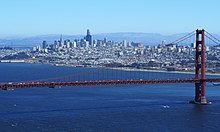Portal:California/Selected article/33
San Francisco, officially the City and County of San Francisco, is a commercial, financial, and cultural center within Northern California. With a population of 808,988 residents as of 2023, San Francisco is the fourth-most populous city in the U.S. state of California behind Los Angeles, San Diego, and San Jose. It covers a land area of 46.9 square miles (121 square kilometers) at the upper end of the San Francisco Peninsula, making it the second-most densely populated major U.S. city behind New York City and the fifth-most densely populated U.S. county, behind four of New York City's boroughs. Among the 92 U.S. cities proper with over 250,000 residents, San Francisco is ranked first by per capita income and sixth by aggregate income as of 2022. San Francisco anchors the 13th most populous metropolitan statistical area in the United States, with almost 4.6 million residents in 2023. The larger San Jose–San Francisco–Oakland combined statistical area, the fifth-largest urban region in the U.S., had a 2023 estimated population of over 9 million.
Prior to European settlement, the modern city proper was inhabited by the Yelamu, who spoke a language now referred to as Ramaytush Ohlone. On June 29, 1776, settlers from New Spain established the Presidio of San Francisco at the Golden Gate, and the Mission San Francisco de Asís a few miles away, both named for Francis of Assisi. The California gold rush of 1849 brought rapid growth, transforming an unimportant hamlet into a busy port, making it the largest city on the West Coast at the time; between 1870 and 1900, approximately one quarter of California's population resided in the city proper. In 1856, San Francisco became a consolidated city-county. After three-quarters of the city was destroyed by the 1906 earthquake and fire, it was quickly rebuilt, hosting the Panama–Pacific International Exposition nine years later. In World War II, it was a major port of embarkation for naval service members shipping out to the Pacific Theater. In 1945, the United Nations Charter was signed in San Francisco, establishing the United Nations and in 1951, the Treaty of San Francisco re-established peaceful relations between Japan and the Allied Powers. After the war, the confluence of returning servicemen, significant immigration, liberalizing attitudes, the rise of the beatnik and hippie countercultures, the sexual revolution, the peace movement growing from opposition to United States involvement in the Vietnam War, and other factors led to the Summer of Love and the gay rights movement, cementing San Francisco as a center of liberal activism in the United States. (Full article...)

